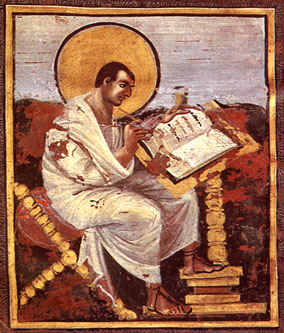| St. Matthew  Born: fl. 1st c. AD Born: fl. 1st c. AD
Birthplace: Palestine
Died: fl. 1st. c. AD
Cause of death: unspecified
Gender: Male
Religion: Christian
Race or Ethnicity: Middle Eastern
Occupation: Religion Nationality: Palestine
Executive summary: Author of the first Gospel St. Matthew, his name probably a shortened form of the Hebrew equivalent to Theodorus, one of the twelve apostles, and the traditional author of the First Gospel, where he is described as having been a tax-gatherer or customs-officer, in the service of the tetrarch Herod. The circumstances of his call to become a follower of Jesus Christ, received as he sat in the customs house in one of the towns by the Sea of Galilee -- apparently Capernaum, are briefly related in Matthew 9:9. We should gather from the parallel narrative in Mark and Luke that he was at the time known as "Levi the son of Alphaeus" (compare Simon Cephas, Joseph Barnabas); if so, "James the son of Alphaeus" may have been his brother. Possibly "Matthew" (Yahweh's gift) was his Christian surname, since two native names, neither being a patronymic, is contrary to Jewish usage. It must be noted, however, that Matthew and Levi were sometimes distinguished in early times, as by Heracleon (c. 170 AD), and more dubiously by Origen, also apparently in the Syriac Didascalia. It has generally been supposed, on the strength of Luke's account, that Matthew gave a feast in Jesus' honor. But Mark 2:15, followed by Matthew 9:10, may mean that the meal in question was one in Jesus' own home at Capernaum. In the lists of the Apostles given in the Synoptic Gospels and in Acts, Matthew ranks third or fourth in the second group of four -- a fair index of his relative importance in the apostolic age. The only other facts related of Matthew on good authority concern him as Evangelist. Eusebius says that he, like John, wrote only at the spur of necessity. "For Matthew, after preaching to Hebrews, when about to go also to others, committed to writing in his native tongue the Gospel that bears his name; and so by his writing supplied, for those whom he was leaving, the loss of his presence." The value of this tradition, which may be based on Papias, who certainly reported that "Matthew compiled the Oracles (of the Lord) in Hebrew", can be estimated only in connection with the study of the Gospel itself. No historical use can be made of the artificial story, in Sanhedrin 43a, that Matthew was condemned to death by a Jewish court. According to the Gnostic Heracleon, quoted by Clement of Alexandria, Matthew died a natural death. The tradition as to his ascetic diet may be due to confusion with Matthias. The earliest legend as to his later labors, one of Syrian origin, places them in the Parthian kingdom, where it represents him as dying a natural death at Hierapolis, equivalent to Mabog on the Euphrates. This agrees with his legend as known to Ambrose and Paulinus of Nola, and is the most probable in itself. The legends which make him work with Andrew among the Anthropophagi near the Black Sea, or again in Ethiopia, are due to confusion with Matthias, who from the first was associated in his Acts with Andrew. Another legend, his Martyrium, makes him labor and suffer in Mysore. He is commemorated as a martyr by the Greek Church on the 16th of November, and by the Roman on the 21st of September, the scene of his martyrdom being placed in Ethiopia. The Latin Breviary also affirms that his body was afterwards translated to Salerno, where it is said to lie in the church built by Robert Guiscard. In Christian art (following Jerome) the Evangelist Matthew is generally symbolized by the "man" in the imagery of Ezekiel 1:10 and Revelations 4:7.
Biblical Figures
Canonization
Do you know something we don't?
Submit a correction or make a comment about this profile
Copyright ©2019 Soylent Communications
|